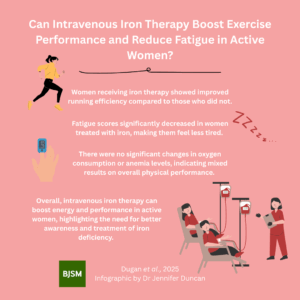Key words: Iron Deficiency, Women’s Health, Exercise Performance
Why is this study important?
Iron deficiency without anemia (IDNA) is a common issue among recreationally active women of reproductive age, driven by factors such as menstrual blood loss and exercise-induced iron depletion (1). While oral iron supplements are often used to address this, they can cause gastrointestinal side effects, leading to a growing interest in intravenous (IV) iron therapy (2). However, the efficacy of IV iron in improving exercise performance and reducing fatigue in non-anemic individuals remains unclear (3). This study, known as the IRONWOMAN trial, aimed to fill this gap by investigating whether IV iron therapy could enhance exercise outcomes and alleviate fatigue in this population (1).
How did the study go about this?
The IRONWOMAN trial was a double-blind, randomized controlled trial conducted in Western Australia. It included 26 recreationally active women aged 18–45 years with IDNA (serum ferritin ≤20 μg/L and hemoglobin ≥115 g/L). Participants were randomly assigned to receive either a single dose of IV iron (iron isomaltoside 1000 mg) or a placebo (saline). Key outcomes, including exercise performance (e.g., running economy, peak oxygen consumption), fatigue scores, mood states, and quality of life, were assessed at baseline, 4 days, and 4 weeks post-intervention. Participants maintained their usual exercise and dietary routines throughout the study.
What did the study find?
The results revealed several key findings:
Iron Status: IV iron significantly improved markers of iron status (serum ferritin, serum iron, and transferrin saturation) compared to placebo. However, individual responses varied widely.
Exercise Performance: While peak oxygen consumption and lactate threshold remained unchanged, running economy improved significantly in the IV iron group after 4 weeks. This suggests more efficient energy utilization during submaximal exercise.
Fatigue Scores: Fatigue scores improved significantly in the IV iron group after 4 weeks, particularly on the Piper Fatigue Scale (22% reduction). No changes were observed in the placebo group.
Mood and Quality of Life: Neither mood states nor quality of life showed significant changes in either group.
What are the key take-home points?
- IV Iron Therapy Can Correct Iron Deficiency: A single dose of IV iron effectively improved iron status within 4 weeks, offering a rapid alternative for those who cannot tolerate oral supplements.
- Enhanced Exercise Economy: Improvements in running economy suggest that IV iron may optimize muscle oxidative capacity and energy efficiency during submaximal exercise rather than enhancing oxygen-carrying capacity or peak performance.
- Reduced Fatigue: The therapy significantly alleviated fatigue symptoms, highlighting its potential non-hematological benefits for overall well-being.
- Individualized Treatment is Key: The variability in individual responses underscores the need for personalized treatment plans when considering IV iron therapy.

Implications for Clinicians:
For clinicians managing recreationally active women with IDNA (serum ferritin <20 μg/L), IV iron therapy may be a valuable option to improve fatigue and exercise efficiency without relying solely on traditional metrics like VO2 max.. However, careful consideration of individual physiological profiles is essential to maximize benefits.
This study provides important insights into the role of IV iron therapy beyond treating anemia, particularly for active women who experience fatigue or performance limitations due to IDNA. Further research is needed to explore the underlying mechanisms and refine treatment guidelines.
Authors Cory Dugan
References
-
Peeling, P., McKay, A., Sim, M. (2022). Iron Deficiency and Anaemia in Athletes. In: Karakochuk, C.D., Zimmermann, M.B., Moretti, D., Kraemer, K. (eds) Nutritional Anemia. Nutrition and Health. Springer, Cham. https://doi.org/10.1007/978-3-031-14521-6_9
-
Cusack, Halee MS, RDN1; Hewlings, Susan PhD, RD2. The Impact of Iron Supplementation on Athletic Performance in Elite-Level Female Athletes–A Systematic Review. Strength and Conditioning Journal 45(3):p 342-353, June 2023. | DOI: 10.1519/SSC.0000000000000742
-
Shand, A., Nassar, N (2021). Rapid increase in intravenous iron therapy for women of reproductive age in Australia. Med J Aust 2021; 214 (6): . || doi: 10.5694/mja2.50979. Published online: 5 April 2021
- Dugan C, Peeling P, Buissink P, et al Effect of intravenous iron therapy on exercise performance, fatigue scores and mood states in iron-deficient recreationally active females of reproductive age: a double-blind, randomised control trial (IRONWOMAN Trial)British Journal of Sports Medicine 2025;59:921-930.